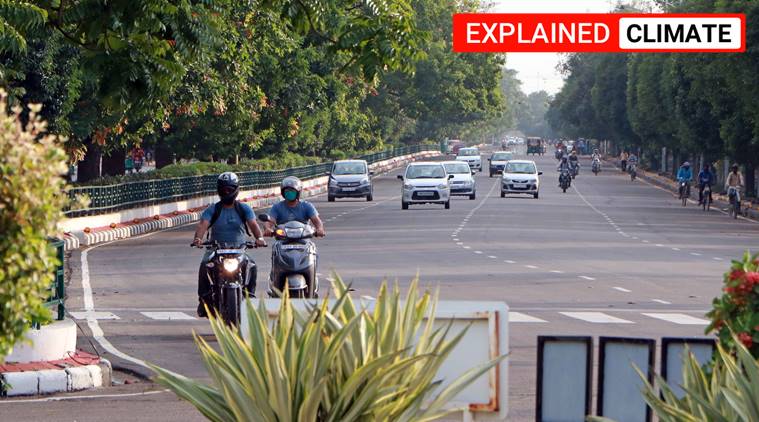- India
- International
Covid-19 lockdown cleared up the air, but harmful ozone levels increased. Here’s why
The Centre for Science and Environment (CSE) said since the starting of the national lockdown, pollution from ozone in 22 mega and metropolitan cities in India "increased and even breached standards in several cities".
 Fewer cars are seen on the road toward YPS Chowk in Mohali due to the coronavirus lockdown, on June 13 2020. (Express Photo: Kamleshwar Singh)
Fewer cars are seen on the road toward YPS Chowk in Mohali due to the coronavirus lockdown, on June 13 2020. (Express Photo: Kamleshwar Singh)
Around the world, Covid-19 lockdowns cleaned up the air as a plethora of economic activities were brought to a standstill. However, new research shows that while NO2 and PM2.5 levels plummeted during this period, pollution from ozone shot up.
On Wednesday, the New Delhi-based Centre for Science and Environment (CSE) said since the starting of the national lockdown on March 25, pollution from ozone in 22 mega and metropolitan cities in India “increased and even breached standards in several cities”.
Ozone as a pollutant
The highly reactive ozone gas (O3) helps protect life when it is in the Earth’s stratosphere. There, it forms the ozone layer, which filters ultraviolet radiation from the sun.
In the troposphere (meaning at ground-level), however, ozone acts as a pollutant that can trigger several health problems among vulnerable groups, and is known to be associated with respiratory and cardiovascular diseases. Along with nitrogen dioxide (NO2) and particulate matter (PM2.5 and PM10), tropospheric ozone is responsible for many of the ill effects caused by outdoor air pollution.
What the CSE study says

The CSE analysed trends for the four major pollutants– PM2.5, PM10, NO2, and ozone– for the period January 1, 2019 to May 31, 2020 in Delhi-NCR (including Faridabad, Ghaziabad, Gurugram and Noida), Kolkata, Chennai, Mumbai, Ahmedabad, Ujjain, Bengaluru, Hyderabad, Jaipur, Jodhpur, Patna, Visakhapatnam, Amritsar, Howrah, Pune, Guwahati, Lucknow and Kochi. The study included spatial trend analysis of ozone in selected cities.
As per the study, as many economic activities stalled during the lockdown, PM2.5 and NO2 levels plummeted in most cities, and this caught public attention. However, the maximum standard average of invisible ozone pollution exceeded standard levels in these cities for several days. In Ahmedabad, the maximum average exceeded the standard for 43 days, Ujjain 38 days, Gurugram 26 days, Ghaziabad 15 days, and Noida 12 days.
In at least one measuring station in Delhi-NCR and Ahmedabad, ozone levels were higher than standard values on two-thirds of lockdown days.
The maps below, provided by CSE, based on CPCB data, show the wide variation in the NO2 and ozone zones in cities despite the comparatively lower levels.










So, why have ozone levels increased?
In many parts of the world, ozone pollution is known to increase during warmer months. It also builds up in cleaner areas.
As per the CSE, this happens because ozone is not directly emitted by any source but is formed by photochemical reactions between oxides of nitrogen (NOx) and other volatile organic compounds (VOCs) and gases in the air under the influence of sunlight and heat. “A high NOx level can again react with ozone and mop it up. The ozone that escapes to cleaner areas has no NOx to further cannibalise it – and as a result, ozone concentration builds up in these areas,” the study explains, “Ozone can be controlled only if gases from all sources are controlled.”
In India, as the lockdown was enforced during the summer months, this effect appears to have compounded, with lower than usual NOx levels at already high temperatures.
📣 The Indian Express is now on Telegram. Click here to join our channel (@indianexpress) and stay updated with the latest headlines
A study conducted by the University of Manchester in May observed similar trends in the UK, where levels of nitrogen oxides decreased by 20 to 80 per cent during the lockdown, but ozone levels increased.
The Manchester team speculated that photochemical production of ozone may become more important in urban areas during summertime in these low conditions of oxides of nitrogen. As nitrogen oxides reduce, photochemical production may become more efficient and can lead to higher ozone concentrations in the summertime as higher temperatures increase emissions of biogenic hydrocarbon from natural sources such as trees, significantly affecting urban ozone levels.
Why this information is important
Across the world, due to lockdowns and social distancing, NOx and particulate matter levels have fallen, clearing up the air. While this is a positive consequence, the high levels of harmful ozone indicate that even the “improved” present conditions can still impact human health.
Anumita Roychowdhury, executive director-research and advocacy, CSE, said, “This pandemic has shown that big reduction is possible only if all regions clean up together and at a scale and with speed across all critical sectors including vehicles, industry, power plants, waste, construction, use of solid fuels for cooking and episodic burning.
“There is a need for an agenda for a ‘blue sky and clear lungs’ for the post-pandemic period to sustain the gains. This action must also ensure the co-benefit of reducing both particulate and gaseous emissions, including ozone,” she added.
More Explained
EXPRESS OPINION
Apr 26: Latest News
- 01
- 02
- 03
- 04
- 05










































